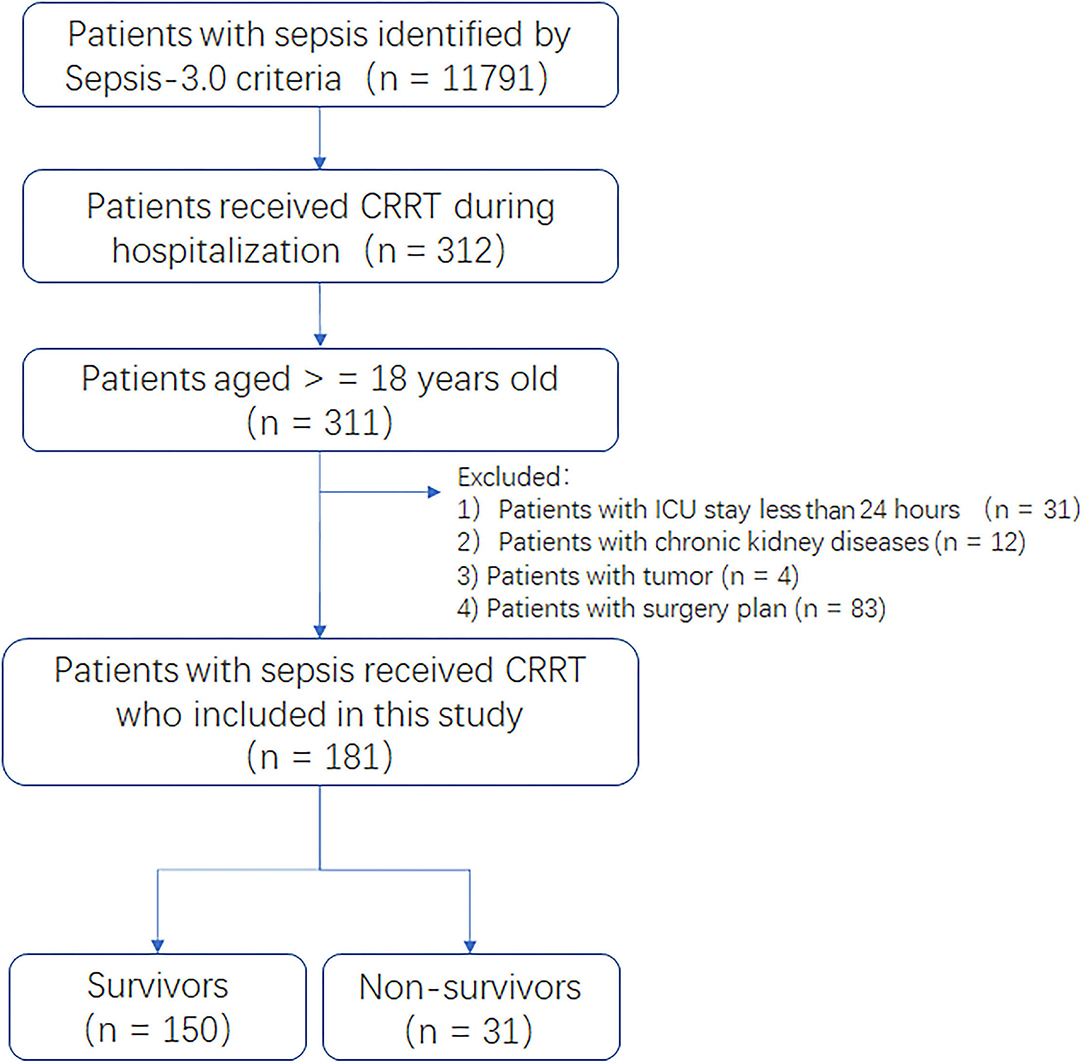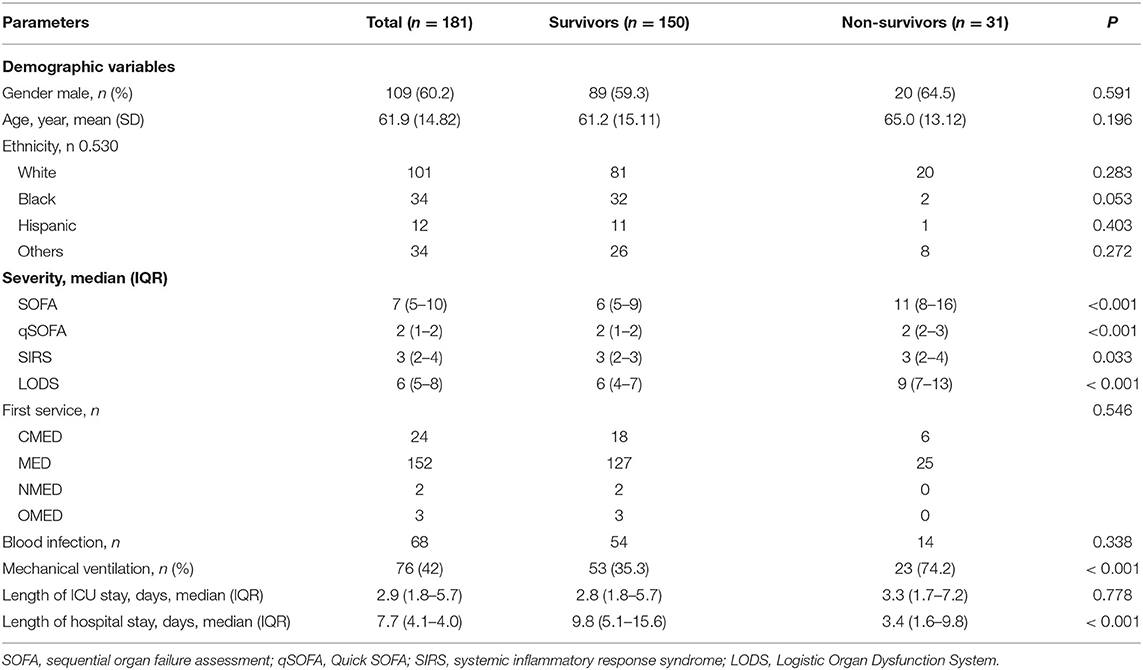- 1Department of Critical Care Medicine, Shanghai Children's Hospital, Shanghai Jiao Tong University, Shanghai, China
- 2Institute of Pediatric Critical Care, Shanghai Jiao Tong University, Shanghai, China
- 3Clinical Research Unit, Shanghai Children's Hospital, Shanghai Jiao Tong University, Shanghai, China
- 4Institute of Pediatric Infection, Immunity, and Critical Care Medicine, Shanghai Jiao Tong University School of Medicine, Shanghai, China
- 5Institute of Medical Information Engineering, University of Shanghai for Science and Technology, Shanghai, China
Background: Sepsis remains the leading cause of mortality in-hospital in the intensive care unit (ICU). Continuous renal replacement therapy (CRRT) is recommended as an adjuvant therapy for hemodynamics management in patients with sepsis. The aim of this study was to develop an adaptive least absolute shrinkage and selection operator (LASSO) for the Cox regression model to predict the hospital mortality in patients with Sepsis-3.0 undergoing CRRT using Medical Information Martin Intensive Care (MIMIC)-III v1.4.
Methods: Patients who met the Sepsis-3.0 definition were identified using the MIMIC-III v1.4. Among them, patients who received CRRT during ICU hospitalization were included in this study. According to the survival status, patients were split into death or survival group. Adaptive LASSO for the Cox regression model was constructed by STATA software. At last, nomogram and Kaplan-Meier curves were drawn to validate the model.
Results: A total of 181 patients who met Sepsis 3.0 criteria received CRRT were included in the study, in which, there were 31 deaths and 150 survivals during hospitalization, respectively. The overall in-hospital mortality was 17.1%. According to the results of multivariate Cox-LASSO regression analysis, use of vasopressor, international normalized ratio (INR) ≥1.5, and quick sequential organ failure assessment (qSOFA) score were associated with hospital mortality in patients with sepsis who underwent CRRT, but lactate level, mechanical ventilation (MV) support, PaO2/FiO2, platelet count, and indicators of acute kidney injury (AKI), such as blood urea nitrogen (BUN) and creatinine, were not independently associated with hospital mortality after adjusted by qSOFA. The risk nomogram and Kaplan-Meier curves verified that the use of vasopressor and INR ≥1.5 possess significant predictive value.
Conclusions: Using the Cox-LASSO regression model, use of vasopressor, INR ≥1.5, and qSOFA score are found to be associated with hospital mortality in patients with Sepsis-3.0 who received CRRT. This finding may assist clinicians in tailoring precise management and therapy for these patients who underwent CRRT.
Introduction
Sepsis is a major condition with high morbidity and mortality in intensive care unit (ICU) patients (1). Severe sepsis and septic shock are characterized by vasoplegia and alterations of microcirculation, resulting in aggressively hemodynamic alterations that render the patient hypotensive or with organ dysfunction (2–5). During sepsis, fluid responsiveness or the use of vasopressors could guide fluid administration (6), but the response to therapy is highly variable (7, 8). Improvement of hemodynamic may not be related to the improvement of microcirculation (4, 9). Septic shock is defined as a microcirculation disease, and many trials showed that the severity of microvascular alterations is associated with outcomes in patients with septic shock (10–14). Evaluation of the response for hemodynamic management is critical for the prognosis of sepsis.
According to the 2020 Surviving Sepsis Campaign (SSC) guidelines, renal replacement therapy (RRT)/continuous RRT (CRRT) has emerged as the preferred modality for critically ill patients to treat acute kidney injury (AKI), fluid overload, particularly, those with hemodynamic instability who are unresponsive to fluid restriction and diuretic therapy (15). In adult septic patients who underwent RRT, microcirculation was improved despite no significant variation in macro-hemodynamics (16). Sepsis-induced aggressively hemodynamic alterations are mainly caused by endothelial dysfunction resulting in the activation of inflammation and coagulation processes (5, 17). CRRT plays an important role in removing toxins and inflammatory factors, and higher TNF-α removal could be related to the lower mortality observed in patients with AKI (18). In addition, patients with sepsis suffer from a higher risk of bleeding and clotting. Anticoagulation is necessary for the effective delivery of CRRT, and anticoagulation for CRRT should be adapted to the patient's characteristics (19). Given the complex roles of CRRT in improving inflammatory response, fluid management, and anticoagulation involved in CRRT management, assessment of the prognosis in patients with sepsis who underwent CRRT could be especial. Until now, the risk factors of worse prognosis in patients with sepsis who received CRRT are limited to be reported.
In the current study, we conducted a retrospective study based on Medical Information Martin Intensive Care (MIMIC) III v1.4 to develop a model based on the potential risk factors related to the outcome of patients with sepsis who need CRRT. The results could be helpful for clinicians to make precise management of these patients.
Methods
Database and Study Population
Study data were acquired from the MIMIC-III database v1.4, which encompasses > 60,000 ICU admissions between 2001 and 2012 for > 46,000 unique patients at Beth Israel Deaconess Medical Center (BIDMC) in Boston, Massachusetts between 2001 and 2012 (20). The information available in MIMIC-III includes dates of admission to the ICU and hospital, demographic, clinical features, laboratory and microbiology test results, fluid balance, critical illness scores, diagnosis codes, and hospital mortality. Use of the MIMIC-III database was approved by the Institutional Review Boards of BIDMC and the Massachusetts Institute of Technology.
Firstly, data extraction adhered to the original Sepsis-3.0 definition as closely as possible (21, 22). According to the report of Johnson (23), the patients who fulfilled the Sepsis-3.0 criteria were automatically extracted using pgAdmin PostgreSQL tools (version 1.22.1). Of these patients, patients who aged over 18-year-old received CRRT during hospitalization were included. We excluded those with conditions who may be associated with hospital mortality, such as: (1) the length of ICU stay <24 h; (2) with chronic kidney disease (International Classification of Diseases [ICD]9-code: 5859); (3) metastatic cancer and solid tumor without metastasis (metastatic cancer: icd9_code: 1960–1991, 20970–20975, 20979, 78951; solid tumor without metastasis: icd9_code: 1400–1729, 1740–1759, 179–1958, 20900–20924, 20925–2093, 20930–20936, 25801–25803); or (4) surgery plan. Patients were divided into two groups based on the record of the hospital expire flag (in-hospital death recorded in the hospital database). The detailed process of patients' selection and data extraction is shown in Figure 1.
Outcomes
The primary outcome was hospital mortality at the first ICU admission. The secondary outcomes were the length of ICU and hospital stay, use of vasopressor, and mechanical ventilation (MV) support.
Data Extraction and Variables Collection
Variables extracted from MIMIC-III database v1.4 included demographics, severity accessed by SOFA, qSOFA, systemic inflammatory response syndrome (SIRS), and Logistic Organ Dysfunction System (LODS) scores, source of patients, vital signs, such as heart rate (HR), systolic blood pressure (BP), diastolic BP, mean arterial pressure (MAP), temperature, respiratory rate (RR), arterial blood gas, such as oxyhemoglobin saturation (SpO2) and PaO2/FiO2, serum laboratory variables that include the minimum of albumin, platelet, the maximum of bilirubin, creatinine, lactate, international normalized ratio (INR), blood urea nitrogen (BUN), and white blood cells (WBC), and the test results of blood infection. Furthermore, oxygen therapy support mode, duration of ventilation, use of vasopressor, and vasopressor duration were accessed. Patient demographics and all necessary variables were calculated using data from the first 24 h of the ICU stay. Furthermore, we set categorical variables based on the values of laboratory indexes within 24 h after ICU admission as below: (1) systolic BP <100 mmHg, (2) whether or not need vasopressor, (3) INR ≥1.5, (4) platelet <100 × 109/L, (5) lactate ≥4 μmol/L, (6) impaired pulmonary function was defined as PaO2/FiO2 >300 mmHg, 200 mmHg < PaO2/FiO2 ≤ 300 mmHg, 100 mmHg < PaO2/FiO2 ≤ 200 mmHg, and PaO2/FiO2 ≤ 100 mmHg. Ultimately, we obtained the list of data based on anonymized patients with Sepsis-3.0 who received CRRT.
Statistical Analysis
All the data analyses were conducted using STATA 15.0 MP (College Station, TX, USA). Variables were displayed and compared between survivors and non-survivors. Normally and non-normally distributed continuous variables were expressed as the mean ± SD and the median (interquartile range, IQR), respectively. Continuous variables of normal distribution were tested by Student's t-test. Mann-Whitney U-test was used to compare continuous data of non-normally distribution. Categorical variables were summarized as numbers or percentage and assessed using the Chi-square test. A p < 0.05 was defined as statistically significant.
Cox survival analysis and least absolute shrinkage and selection operator (LASSO) regression univariable regression analyses were performed to assess the association of each variable with hospital mortality, and values of p < 0.05 were selected as a candidate variable. The method of LASSO was used to select predictors. Multivariate Cox regression was further performed to assess the prognostic value of selected variables, with qSOFA as an adjustment factor. The hazard ratio (HR) and 95% CI were estimated by Cox proportional hazards regression model.
Construction and Validation of a Prognostic Nomogram for Hospital Mortality
Nomogram were constructed to calculate an individual's probability of hospital mortality by using STATA software. In the nomogram, the patient was scored according to the variables entered multivariate Cox proportional hazards regression model. The final sum of the scores was expected to be the corresponding hospital mortality probability. Kaplan-Meier curves were drawn and compared the differences in hospital mortality between groups divided by the variables of the nomogram.
Results
Baseline Characteristics
There were 11,791 patients with Sepsis-3.0 between 2008 and 2012. In this cohort, 312 patients received CRRT during hospitalization. One patient aged less 18-year-old, 31 cases with the length of ICU stay <24 h, 12 patients with chronic kidney disease, 4 patients with tumor, and 83 patients with surgery plan were excluded. Finally, there were 181 patients with Sepsis-3.0 who underwent CRRT during hospitalization, in which, there were 31 deaths and 150 survivals during hospitalization, respectively.
In these patients, the age, gender, ethnicity, first service type, blood infection, and the length of ICU stay showed no significant difference between survival and non-survival groups. The ratio of MV was higher in non-survivors than survivors, and the length of hospital stay was shorter in non-survivors than survivors (Table 1).
Laboratory Indexes Within the First 24 h After ICU Admission
Minimum systolic BP, minimum diastolic BP, minimum MAP, maximum RR, maximum lactate, maximum creatinine, maximum bilirubin, minimum platelet, maximum INR, minimum albumin, ratio of vasopressor needed, and respiratory support were significantly different between survivors and non-survivors. However, maximum HR, maximum temperature, maximum glucose, maximum BUN, minimum WBC, maximum WBC, SpO2, PaO2/FiO2, vasopressor duration, and ventilation durations showed no significant difference between the two groups (Table 2).
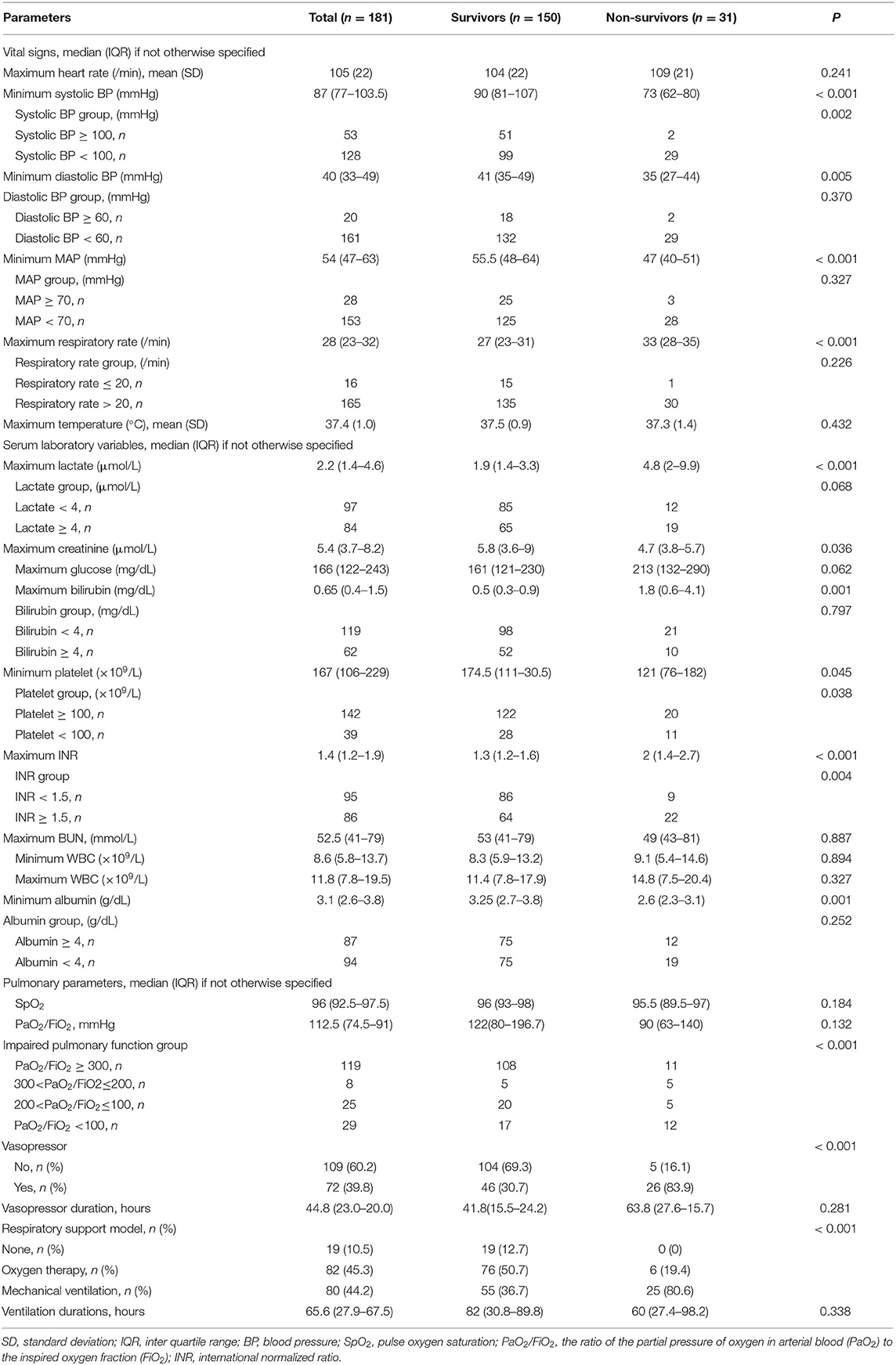
Table 2. Laboratory indexes within 24 h after ICU admission in patients with sepsis who received CRRT.
Relationship Between Clinical and Laboratory Indexes and Hospital Mortality
Overall hospital mortality was 17.1% (31/181). The ratio of MV needed was 44.2% (80/181), and the ratio of use of vasopressor was 39.8% (72/181). The hospital mortality was 36.1% (26/72) in patients who received vasopressor and 4.6% (5/109) in patients without vasopressor support (p < 0.001). In a subgroup of patients who received MV support, the hospital mortality was 31.3 (25/80), which was significantly higher than that 7.3% (6/82) in patients with oxygen therapy, and all 19 patients without any oxygen therapy were survival.
Identification of Risk Factors of Hospital Mortality by Cox-LASSO Analysis
According to the results of Table 2, laboratory variables and categorical variables with statistically significant differences between survivors and non-survivors were entered in the Univariate Cox analysis. The results showed that systolic BP <100 mmHg, the use of vasopressor, INR ≥1.5, maximum lactate, maximum creatinine, and impaired severity of pulmonary function were associated with hospital mortality in patients with sepsis undergoing CRRT (all p < 0.05; Table 3). Furthermore, LASSO regression analysis was used to screen these variables. Adaptive LASSO regression analysis indicated that the categorical variables, such as the use of vasopressor, INR ≥ 1.5, impaired severity of pulmonary function, but not the absolute values of laboratory indexes, were entered multivariate Cox regression model (Figure 2). Finally, multivariate Cox regression model based on the adaptive LASSO displayed that the use of vasopressor and INR ≥ 1.5 were risk factors of hospital mortality in patients with Sepsis-3.0 who received CRRT adjusted by qSOFA (Table 4).
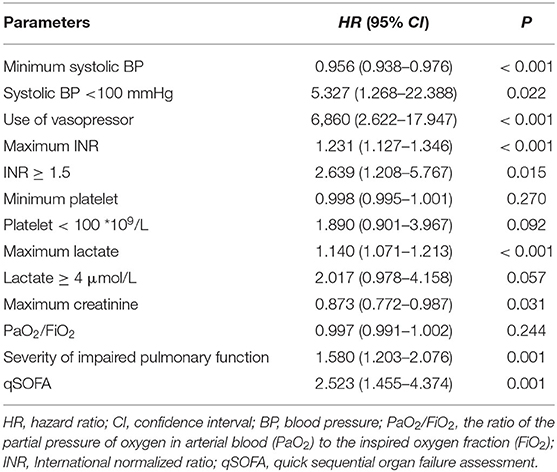
Table 3. Univariate Cox analysis of factor related to hospital mortality in patients with sepsis received CRRT.
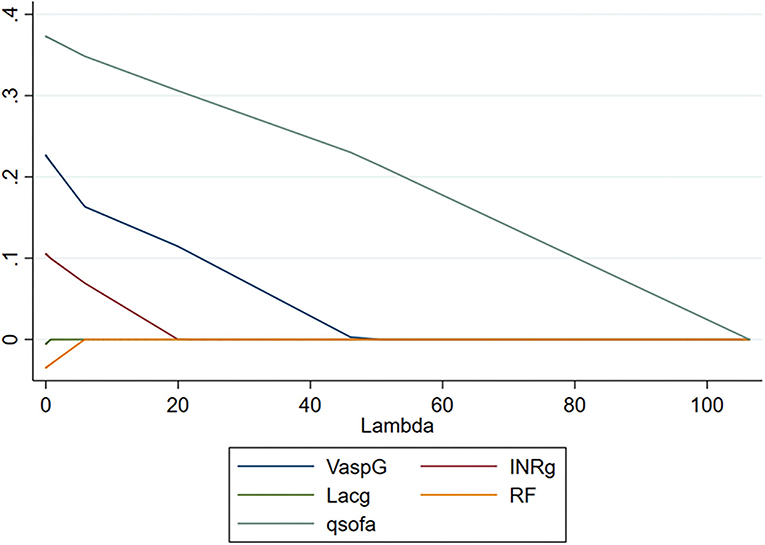
Figure 2. LASSO regression analysis for hospital mortality in patients with Sepsis-3.0 who received CRRT. VaspG (blue line): use of vasopressor; INRg (purple line): INR >1.5; Lacg (green line): lactate ≥4 μmol/L; RF (orange line): severity of impaired pulmonary function (defined as PaO2/FiO2 (PF) >300 mmHg, 200 mmHg < PF ≤ 300 mmHg, 100 mmHg < PF ≤ 200 mmHg, PF ≤ 100 mmHg); qSOFA (dark green line): qSOFA score. LASSO, least absolute shrinkage and selection operator; CRRT, continuous renal replacement therapy; qSOFA, quick sequential organ failure assessment; INR, international normalized ratio.
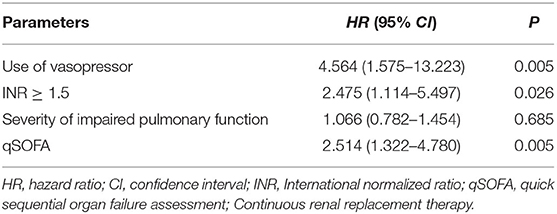
Table 4. Multivariate Cox analysis of factor related to hospital mortality based on LASSO regression in patients with sepsis received CRRT.
A New Prognostic Nomogram for Patients With Sepsis-3.0 Who Underwent CRRT
To provide a quantitative method for clinical outcome prediction, we constructed a prognostic nomogram, such as the use of vasopressor, INR ≥ 1.5, the severity of impaired pulmonary function, and qSOFA, to predict the hospital mortality of patients with Sepsis-3.0. As shown in Figure 3, total scores were derived from the sum of the individual scores of various risk factors. In this nomogram, a higher total number of points indicated worse hospital mortality.
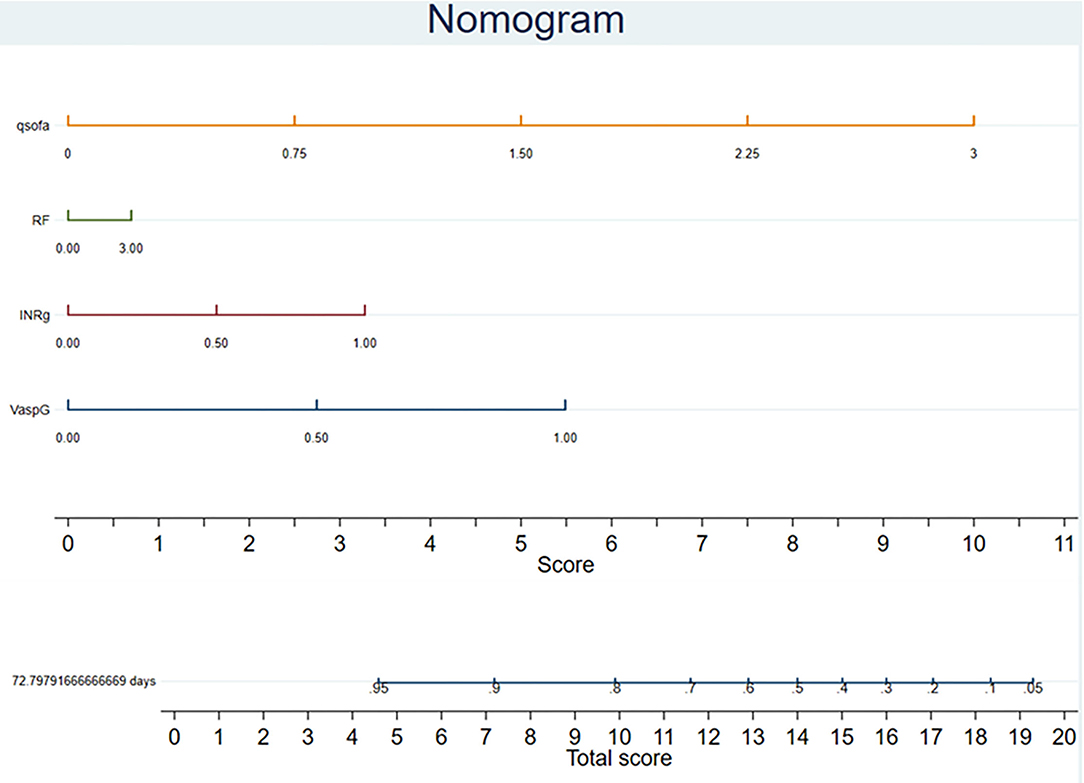
Figure 3. Top features were selected using multivariate Cox-LASSO regression analysis and the corresponding variable importance score. The X-axis indicates the importance score, which is the relative number of a variable that is used to distribute the data, the Y-axis indicates the top-weighted variables. qSOFA (orange line): quick sequential organ failure assessment; RF (green line): impaired severity of pulmonary function (defined as PaO2/FiO2 [PF]) > 300 mmHg, 200 mmHg < PF ≤ 300 mmHg, 100 mmHg < PF ≤ 200 mmHg, PF ≤ 100 mmHg). INRg (purple line): INR > 1.5; VaspG (blue line): use of vasopressor. LASSO, least absolute shrinkage and selection operator; CRRT, continuous renal replacement therapy; qSOFA, quick sequential organ failure assessment; INR, international normalized ratio.
Stratified Analysis of Prognostic Factors Using Kaplan-Meier Curves
Further, we evaluated the prognostic value of the use of vasopressor, INR > 1.5, the severity of impaired pulmonary function, and qSOFA score for the patients with Sepsis-3.0 who received CRRT. A significant difference in clinical outcomes was observed between with and without vasopressor support (Figure 4A, p < 0.001), INR > 1.5 compared with INR ≤ 1.5 (Figure 4B, p = 0.012), among different severity of impaired pulmonary function indicated with the value of PaO2/FiO2 (Figure 4C, p < 0.001), and with or without MV support (Figure 4D, p < 0.001).
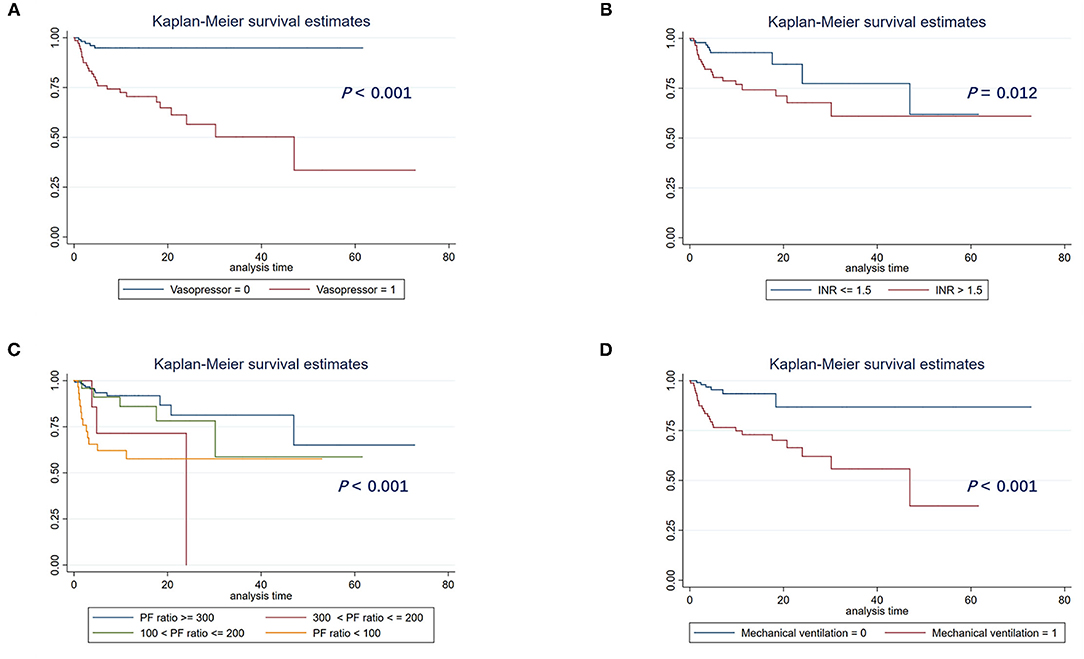
Figure 4. Kaplan-Meier survival curve analysis of hospital mortality in patients stratified by prognostic factors based on Cox-LASSO analysis. (A) With vs. without vasopressor; (B) INF ≤ 1.5 vs. INR >1.5; (C) PaO2/FiO2 (PF) >300 mmHg vs. 200 mmHg < PF ≤ 300 mmHg vs. 100 mmHg < PF ≤ 200 mmHg vs. PF ≤ 100 mmHg); (D) with or without mechanical ventilation support. LASSO, least absolute shrinkage and selection operator; INR, international normalized ratio.
Discussion
Sepsis-induced aggressive hemodynamic alterations are one of the main causes for high mortality in patients with sepsis. CRRT, as a recommended management for hemodynamic stable, is paid more attention in recent years. In the present study, the retrospective study based on MIMIC-III v1.4 developed a Cox-LASSO model to show that use of vasopressor and INR ≥ 1.5 are found to be risk factors of hospital mortality in patients with sepsis who received CRRT. These findings may assist clinicians in tailoring precise management and therapy for these patients who underwent CRRT.
According to the international guideline for the management of sepsis in 2016 (24), CRRT is suggested to be used to facilitate the management of fluid balance in hemodynamically unstable septic patients. In the present study, the ratio of CRRT support in patients who met the criteria of Sepsis-3.0 was 2.6% (312/11791). There were about 5–6% of ICU patients with AKI who will receive RRT (25). This result is much lower than the ratio of CRRT application in patients with sepsis in adult ICU in China (16.3%) (26) and in pediatric ICU according to our previous study (10.7%) (27). As reported, the ratio of CRRT used in a patient with COVID-19-induced that AKI was from 3.9% (225/5700) to 8.7% (280/3235) in the USA (28). MIMIC-III v1.4 did not include detailed information about the indications for CRRT in each patient. According to the baseline characteristics of patients with sepsis who received CRRT, there were high ratio (70.7%, 128/181) of systolic BP <100 mmHg, high lactate levels (≥ 4 μmol/L) (46.4%, 84/181), high ratio of vasopressor support (39.8%, 72/181), and a high ratio of MV support (44.2%, 80/181). Miao et al. (29) reported the indications of CRRT in pediatric severe sepsis (http://links.lww.com/CCM/E733). Whether there are more detailed differences in CRRT application between pediatric and adult patients with sepsis who need further investigation in a well-designed study.
In adult ICU, hospital mortality and 28-day mortality ranged from 50.4 to 64.5% in patients with septic AKI under CRRT (30, 31). The recent insights and results from large randomized and non-randomized trials in the area of RRT applied for sepsis-induced AKI do not seem to improve survival or renal recovery (32). Our previous study indicated that CRRT decreases hospital mortality rate from 32.4% (44/136) to 21.3% (29/136) in pediatric patients with severe sepsis (29). Moreover, there is no evidence to indicate that high-volume hemofiltration (HVHF) is superior to standard-volume continuous veno-venous hemofiltration (CVVH) in the aspect of reducing 28-day mortality in pediatric patients with severe sepsis (24.7 vs. 33.8%, p = 0.216) (33). In our present study, the total hospital mortality was 17.1% (31/181). In the subgroup, the hospital mortality was 22.6% (19/84) in patients with lactate ≥ 4 μmol/L, 22.6% (29/128) with systolic BP <100 mmHg, 31.3% with MV support, and 36.1% (26/72) with vasopressor support. These findings give an overview of the clinical benefits of CRRT in adult sepsis.
Hypotension or the need for vasoactive drugs was associated with mortality (34). In our present study, the need for vasoactive drugs, but not hypotension (defined as systolic BP <100 mmHg), on ICU admission was entered the LASSO model for mortality in a patient with sepsis under CRRT. In addition, thrombocytopenia prior to the initiation of CRRT and severe thrombocytopenia prior to and following the initiation of CRRT were associated with increased ICU mortality (35). In the present study, though the ratio of patients with platelets <100 × 109/L was higher in non-survivors than survivors, the ratio of patients with platelets <100 × 109/L on admission was not an independent factor for mortality in patients under CRRT support. Moreover, AKI is a main indication for CRRT initiation, but the levels of serum creatinine were relatively lower in non-survivors than survivors, and there were no differences in the levels of BUN between the two groups. Consistently, there was a report that the severity of the AKI at the time of CRRT start did not have a significant relationship with the burned patient outcome with CRRT (36). Otherwise, in sepsis patients with AKI treated with CRRT, age, Acute Physiology and Chronic Health Evaluation (APACHE) II, SOAF, and grade IV of cardiac function were independent risk factors for death (37). In this study, qSOFA score was associated with mortality in patients treated with CRRT.
There are several limitations in this study. Firstly, we could not collect the detailed information about fluid overload in patients with sepsis. Secondly, the indications for CRRT were lacking in this study. Thirdly, as a database study, the interval time between sepsis occurrence and CRRT initiation was lacking. All these limitations could lead to bias for the present conclusions of this study, which needs further confirmation in a well-designed prospective study.
Conclusions
In summary, we found that the use of vasopressor, INR ≥ 1.5, and qSOFA score are outcome of patients with sepsis who received CRRT based on MIMIC-III v1.4. After adjusted by qSOFA score, either lactate level or MV support is independently associated with the hospital mortality. These findings may assist clinicians in tailoring precise management of hemodynamics and coagulation disorders for these patients who underwent CRRT.
Data Availability Statement
The datasets presented in this study can be found in online repositories. The names of the repository/repositories and accession number(s) can be found in the article/Supplementary Material.
Ethics Statement
Ethical review and approval was not required for the study on human participants in accordance with the local legislation and institutional requirements. Written informed consent for participation was not required for this study in accordance with the national legislation and the institutional requirements.
Author Contributions
CW and YZ conceptualized the research aims. CW planned the analyses, guided the literature review, and drafted the manuscript. JZ extracted the data from the MIMIC-III database. CW, JZ, and JW participated in processing the data and doing the statistical analysis. LZ and YZ provided comments and approved the final manuscript. All authors read and approved the final manuscript.
Funding
This work was supported by the National Natural Science Foundation of China (82171729), the Natural Science Foundation of Shanghai (19ZR1442500), and National Key R&D Program of China (2020YFC2005802 and 2020YFC2005800). CW was funded by the Shanghai Municipal Education Commission-Gaofeng Clinical Medicine Grant (20171928) and the talent program from Shanghai Jiao Tong University School of Medicine (17XJ11018).
Conflict of Interest
The authors declare that the research was conducted in the absence of any commercial or financial relationships that could be construed as a potential conflict of interest.
Publisher's Note
All claims expressed in this article are solely those of the authors and do not necessarily represent those of their affiliated organizations, or those of the publisher, the editors and the reviewers. Any product that may be evaluated in this article, or claim that may be made by its manufacturer, is not guaranteed or endorsed by the publisher.
Supplementary Material
The Supplementary Material for this article can be found online at: https://www.frontiersin.org/articles/10.3389/fmed.2021.778536/full#supplementary-material
Abbreviations
BP, blood pressure; BUN, blood urea nitrogen; CI, confidence intervals; CRRT, continuous renal replacement therapy; HR, hazard ratio; ICD, International Classification of Diseases; ICU, intensive care unit; INR, international normalized ratio; LODS, Logistic Organ Dysfunction System; MIMIC, Medical Information Mart for Intensive Care; PaO2/FiO2, the ratio of the partial pressure of oxygen in arterial blood (PaO2) to the inspired oxygen fraction (FiO2); qSOFA, quick sequential organ failure assessment; SIRS, systemic inflammatory response syndrome; SOFA, sequential organ failure assessment; SpO2, oxyhemoglobin saturation; SSC, surviving sepsis campaign; WBC, white blood cells.
References
1. Rudd KE, Johnson SC, Agesa KM, Shackelford KA, Tsoi D, Kievlan DR, et al. Global, regional, and national sepsis incidence and mortality, 1990-2017: analysis for the Global Burden of Disease Study. Lancet. (2020) 395:200–11. doi: 10.1016/S0140-6736(19)32989-7
2. Pan P, Su L, Liu D, Wang X. Microcirculation-guided protection strategy in hemodynamic therapy. Clin Hemorheol Microcirc. (2020) 75:243–53. doi: 10.3233/CH-190784
3. Puntillo F, Giglio M, Pasqualucci A, Brienza N, Paladini A, Varrassi G. Vasopressor-sparing action of methylene blue in severe sepsis and shock: a narrative review. Adv Ther. (2020) 37:3692–706. doi: 10.1007/s12325-020-01422-x
4. Scheuzger J, Zehnder A, Meier V, Yeginsoy D, Flukiger J, Siegemund M. Sublingual microcirculation does not reflect red blood cell transfusion thresholds in the intensive care unit-a prospective observational study in the intensive care unit. Crit Care. (2020) 24:18. doi: 10.1186/s13054-020-2728-7
5. De Backer D, Ricottilli F, Ospina-Tascon GA. Septic shock: a microcirculation disease. Curr Opin Anaesthesiol. (2021) 34:85–91. doi: 10.1097/ACO.0000000000000957
6. Douglas IS, Alapat PM, Corl KA, Exline MC, Forni LG, Holder AL, et al. Fluid response evaluation in sepsis hypotension and shock: a randomized clinical trial. Chest. (2020) 158:1431–45. doi: 10.1016/j.chest.2020.04.025
7. Potter EK, Hodgson L, Creagh-Brown B, Forni LG. Manipulating the microcirculation in sepsis - the impact of vasoactive medications on microcirculatory blood flow: a systematic review. Shock. (2019) 52:5–12. doi: 10.1097/SHK.0000000000001239
8. van Loon LM, van der Hoeven JG, Lemson J. Hemodynamic response to beta-blockers in severe sepsis and septic shock: a review of current literature. J Crit Care. (2019) 50:138–43. doi: 10.1016/j.jcrc.2018.12.003
9. Collet M, Huot B, Barthelemy R, Damoisel C, Payen D, Mebazaa A, et al. Influence of systemic hemodynamics on microcirculation during sepsis. J Crit Care. (2019) 52:213–8. doi: 10.1016/j.jcrc.2019.05.002
10. Pranskunas A, Koopmans M, Koetsier PM, Pilvinis V, Boerma EC. Microcirculatory blood flow as a tool to select ICU patients eligible for fluid therapy. Intensive Care Med. (2013) 39:612–9. doi: 10.1007/s00134-012-2793-8
11. Massey MJ, Hou PC, Filbin M, Wang H, Ngo L, Huang DT, et al. Microcirculatory perfusion disturbances in septic shock: results from the ProCESS trial. Crit Care. (2018) 22:308. doi: 10.1186/s13054-018-2240-5
12. Scorcella C, Damiani E, Domizi R, Pierantozzi S, Tondi S, Carsetti A, et al. MicroDAIMON study: Microcirculatory DAIly MONitoring in critically ill patients: a prospective observational study. Ann Intensive Care. (2018) 8:64. doi: 10.1186/s13613-018-0411-9
13. Kazune S, Grabovskis A, Cescon C, Strike E, Vanags I. Association between increased arterial stiffness and clinical outcomes in patients with early sepsis: a prospective observational cohort study. Intensive Care Med Exp. (2019) 7:26. doi: 10.1186/s40635-019-0252-3
14. Rovas A, Seidel LM, Vink H, Pohlkotter T, Pavenstadt H, Ertmer C, et al. Association of sublingual microcirculation parameters and endothelial glycocalyx dimensions in resuscitated sepsis. Crit Care. (2019) 23:260. doi: 10.1186/s13054-019-2542-2
15. Weiss SL, Peters MJ, Alhazzani W, Agus MSD, Flori HR, Inwald DP, et al. Surviving sepsis campaign international guidelines for the management of septic shock and sepsis-associated organ dysfunction in children. Intensive Care Med. (2020) 46:10–67. doi: 10.1007/s00134-019-05878-6
16. Zuccari S, Damiani E, Domizi R, Scorcella C, D'Arezzo M, Carsetti A, et al. Changes in cytokines, haemodynamics and microcirculation in patients with sepsis/septic shock undergoing continuous renal replacement therapy and blood purification with CytoSorb. Blood Purif. (2020) 49:107–13. doi: 10.1159/000502540
17. McHale TM, Garciarena CD, Fagan RP, Smith SGJ, Martin-Loches I, Curley GF, et al. Inhibition of vascular endothelial cell leak following Escherichia coli attachment in an experimental model of sepsis. Crit Care Med. (2018) 46:e805–10. doi: 10.1097/CCM.0000000000003219
18. Quinto BM, Iizuka IJ, Monte JC, Santos BF, Pereira V, Durao MS, et al. TNF-alpha depuration is a predictor of mortality in critically ill patients under continuous veno-venous hemodiafiltration treatment. Cytokine. (2015) 71:255–60. doi: 10.1016/j.cyto.2014.10.024
19. Tolwani AJ, Wille KM. Anticoagulation for continuous renal replacement therapy. Semin Dial. (2009) 22:141–5. doi: 10.1111/j.1525-139X.2008.00545.x
20. Johnson AE, Pollard TJ, Shen L, Lehman LW, Feng M, Ghassemi M, et al. MIMIC-III, a freely accessible critical care database. Sci Data. (2016) 3:160035. doi: 10.1038/sdata.2016.35
21. Seymour CW, Liu VX, Iwashyna TJ, Brunkhorst FM, Rea TD, Scherag A, et al. Assessment of clinical criteria for sepsis: for the third international consensus definitions for sepsis and septic shock (Sepsis-3). JAMA. (2016) 315:762–74. doi: 10.1001/jama.2016.0288
22. Singer M, Deutschman CS, Seymour CW, Shankar-Hari M, Annane D, Bauer M, et al. The third international consensus definitions for sepsis and septic shock (Sepsis-3). JAMA. (2016) 315:801–10. doi: 10.1001/jama.2016.0287
23. Johnson AEW, Aboab J, Raffa JD, Pollard TJ, Deliberato RO, Celi LA, et al. A comparative analysis of sepsis identification methods in an electronic database. Crit Care Med. (2018) 46:494–9. doi: 10.1097/CCM.0000000000002965
24. Rhodes A, Evans LE, Alhazzani W, Levy MM, Antonelli M, Ferrer R, et al. Surviving sepsis campaign: international guidelines for management of sepsis and septic shock: 2016. Intensive Care Med. (2017) 43:304–77. doi: 10.1007/s00134-017-4683-6
25. Heung M, Bagshaw SM, House AA, Juncos LA, Piazza R, Goldstein SL. CRRTnet: a prospective, multi-national, observational study of continuous renal replacement therapy practices. BMC Nephrol. (2017) 18:222. doi: 10.1186/s12882-017-0650-2
26. Xie J, Wang H, Kang Y, Zhou L, Liu Z, Qin B, et al. The epidemiology of sepsis in Chinese ICUs: a national cross-sectional survey. Crit Care Med. (2020) 48:e209–18. doi: 10.1097/CCM.0000000000004155
27. Tang X, Shao L, Dou J, Zhou Y, Chen M, Cui Y, et al. Fibrinogen as a prognostic predictor in pediatric patients with sepsis: a database study. Med Inflamm. (2020) 2020:9153620. doi: 10.1155/2020/9153620
28. Lin L, Wang X, Ren J, Sun Y, Yu R, Li K, et al. Risk factors and prognosis for COVID-19-induced acute kidney injury: a meta-analysis. BMJ Open. (2020) 10:e042573. doi: 10.1136/bmjopen-2020-042573
29. Miao H, Shi J, Wang C, Lu G, Zhu X, Wang Y, et al. Continuous renal replacement therapy in pediatric severe sepsis: a propensity score-matched prospective multicenter cohort study in the PICU. Crit Care Med. (2019) 47:e806–13. doi: 10.1097/CCM.0000000000003901
30. Perez-Fernandez X, Sabater-Riera J, Sileanu FE, Vazquez-Reveron J, Ballus-Noguera J, Cardenas-Campos P, et al. Clinical variables associated with poor outcome from sepsis-associated acute kidney injury and the relationship with timing of initiation of renal replacement therapy. J Crit Care. (2017) 40:154–60. doi: 10.1016/j.jcrc.2017.03.022
31. Park JT, Lee H, Kee YK, Park S, Oh HJ, Han SH, et al. High-dose versus conventional-dose continuous venovenous hemodiafiltration and patient and kidney survival and cytokine removal in sepsis-associated acute kidney injury: a randomized controlled trial. Am J Kidney Dis. (2016) 68:599–608. doi: 10.1053/j.ajkd.2016.02.049
32. Romagnoli S, Ricci Z, Ronco C. CRRT for sepsis-induced acute kidney injury. Curr Opin Crit Care. (2018) 24:483–92. doi: 10.1097/MCC.0000000000000544
33. Miao H, Wang F, Xiong X, Wang C, Zhang Y. Clinical benefits of high-volume hemofiltration in critically ill pediatric patients with severe sepsis: a retrospective cohort study. Blood Purif. (2018) 45:18–27. doi: 10.1159/000481249
34. Santiago MJ, Lopez-Herce J, Urbano J, Solana MJ, del Castillo J, Ballestero Y, et al. Clinical course and mortality risk factors in critically ill children requiring continuous renal replacement therapy. Intensive Care Med. (2010) 36:843–9. doi: 10.1007/s00134-010-1858-9
35. Guru PK, Singh TD, Akhoundi A, Kashani KB. Association of thrombocytopenia and mortality in critically ill patients on continuous renal replacement therapy. Nephron. (2016) 133:175–82. doi: 10.1159/000447543
36. Yoon J, Kim Y, Yim H, Cho YS, Kym D, Hur J, et al. Analysis of prognostic factors for acute kidney injury with continuous renal replacement therapy in severely burned patients. Burns. (2017) 43:1418–26. doi: 10.1016/j.burns.2017.03.015
37. Zhang Q, Fei Y, Jiang L. [Risk factors for mortality in intensive care unit patients with sepsis combined with acute kidney injury after continuous renal replacement therapy: secondary analysis of the data from a multicenter observational study]. Zhonghua Wei Zhong Bing Ji Jiu Yi Xue. (2019) 31:155–9. doi: 10.3760/cma.j.issn.2095-4352.2019.02.007
Keywords: MIMIC-III, Sepsis-3.0, LASSO, Cox regression, mortality, CRRT
Citation: Wang C, Zheng J, Wang J, Zou L and Zhang Y (2022) Cox-LASSO Analysis for Hospital Mortality in Patients With Sepsis Received Continuous Renal Replacement Therapy: A MIMIC-III Database Study. Front. Med. 8:778536. doi: 10.3389/fmed.2021.778536
Received: 17 September 2021; Accepted: 31 December 2021;
Published: 10 February 2022.
Edited by:
Xiaotong Hou, Capital Medical University, ChinaReviewed by:
Pasquale Sansone, University of Campania Luigi Vanvitelli, ItalyYumei Li, Jilin University, China
Copyright © 2022 Wang, Zheng, Wang, Zou and Zhang. This is an open-access article distributed under the terms of the Creative Commons Attribution License (CC BY). The use, distribution or reproduction in other forums is permitted, provided the original author(s) and the copyright owner(s) are credited and that the original publication in this journal is cited, in accordance with accepted academic practice. No use, distribution or reproduction is permitted which does not comply with these terms.
*Correspondence: Chunxia Wang, a2FyZW5jeDA0NjVAMTYzLmNvbQ==; Yucai Zhang, enl1Y2FpMjAxOEAxNjMuY29t
†These authors have contributed equally to this work
 Chunxia Wang
Chunxia Wang Jianli Zheng5†
Jianli Zheng5† Yucai Zhang
Yucai Zhang